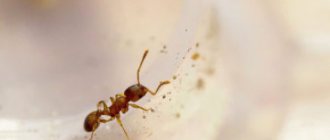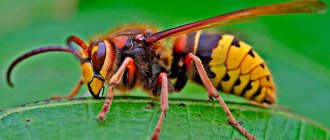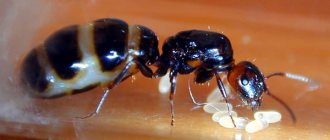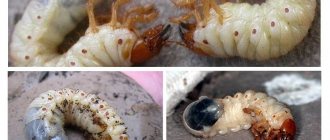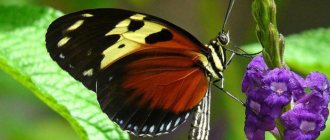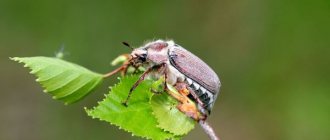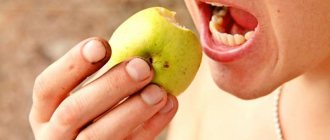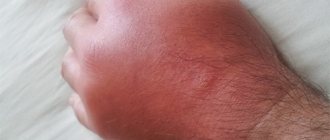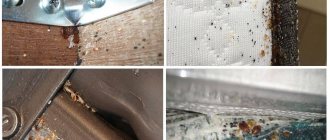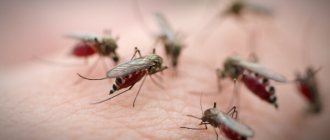Appearance and anatomy of a wasp
You can find out what this insect looks like from a biology textbook.
Since it is impossible to tell everything about wasps in one article, we should focus on the most common species - the common wasp. These winged insects differ from their relatives in their striped colors. The average body length of the insect is 2-3.5 cm. On the yellow-black back there are four wings, with a pair of hind wings linked to a pair of front wings, which is why it visually seems that there are only two wings.
Interestingly, the size of the wasp depends on the gender of the insect. Females are considered larger, and can reach 5.5 cm in length. Such individuals are found in warm countries with a tropical climate.
The system of visual organs in wasps is no less curious. They have not two, but five eyes, which allows them to get maximum visibility of their surroundings.
In addition to the visual system, multifunctional antennae are of great importance for the life of insects. They play the role of a kind of antennas, being at the same time organs of touch, smell, taste buds and a measuring device.
Interestingly, when building a nest, wasps measure each cell with their whiskers.
The internal structure of wasps is similar to bees. Both Hymenoptera have a sting in the lower part of their abdomen, a thin organ associated with a gland that produces toxic venom. Only females can sting, so males are generally considered harmless.
Nature endowed them with this ability so that they could protect themselves, their offspring and their nest from larger insects (for example, from a hornet).
Where are wasps found?
Species of wasps that live in families build nests consisting of individual elements called honeycombs. Insects build their nests not far from places where there is a lot of building material and food. Often, abandoned nests, rodent holes, tree hollows, etc. serve as such places for this. It is not so rare for wasps to appear on garden plots or summer cottages, in various outbuildings, in the attics of houses, on balconies, etc. Here they live and raise their offspring throughout the summer, and with the arrival of autumn they leave the nest. Only young, fertilized females survive and find refuge in various places.
Solitary wasps are found exclusively among wildlife. At night, they can be on the stems of various plants, holding onto them with their paws and jaws. They can climb into a flower. These insects behave like nomads, constantly changing their location.
Types of wasps
Zoologists have described a huge number of varieties of wasps. They differ in the pattern located on the head, usually in the front part. In most cases, the drawing stands out for its clarity, but its shape can be very different. For example, the common wasp has a pattern in the shape of an anchor.
All types of wasps belong to one of two categories: social representatives of these insects and solitary ones. What this means will be discussed later. First, let’s describe some of the representatives of these types. And let's start with the first of them.
Paper wasps are a group that includes many subfamilies. Only in the central regions of Europe there are about 60 such species, and around the world there are about a thousand.
These insects are also simply called social wasps, since they live in colonies that have a cohesive and very interesting social structure.
And such wasps earned their first name – “paper” – because of the way they build their nests. This will also be discussed later.
Paper wasps get their name from their nest material, which resembles paper.
Hornets are the name of a whole genus of paper wasps. Moreover, its representatives are distinguished by significant sizes, reaching a length of 55 cm (but these are the largest). Such insects live in the Northern Hemisphere and are considered endangered today, and therefore it is clear that they are not common.
The hornet wasp has a significant width of the crown and a rounded abdomen compared to other relatives. The venom of such insects is incredibly effective, and therefore their bites are extremely painful. And the person affected by them, as a rule, receives medical assistance.
These attacks are all the more dangerous because such an insect is capable of making several injections of poison in a row. Deaths among people affected by such attacks are also common. Hornets have recently been classified as true wasps - a family that also includes the subfamilies Vespina and Polistina.
The hornet and the wasp are similar in appearance, but differ in size
Solitary wasps, as the name itself suggests, differ from their social relatives in their natural predisposition to a solitary existence. Such insects include the following subfamilies of the wasp kingdom, which are worthy of special mention.
1. Flower wasps are small creatures whose length usually does not exceed a centimeter. Their food consists of pollen and flower nectar. They build their nests from sand and clay, moistening them with saliva.
Their life cycle, including the larval stage, is about two years. In total, about a hundred varieties of such wasps are known. They usually hang around in places where there is a source of food for them, that is, flowers.
2. Sand wasps . There are many more species of such insects, compared to those just described. There are about 8800 of them in the world. Their body length can be quite small, about half a centimeter.
But there are larger specimens. Their sizes reach up to 2 cm. They are found mainly in the tropics. They feed on insects, first paralyzing them with their poison. Nests are built in the ground.
The body of most wasps is black and yellow.
There is a wide variety of sand wasps, including sand and burrowing ones.
But there are exceptions, because specimens of unusual colors live on earth. For example, black wasps . These insects can be large or medium in size.
Their venom is extremely toxic. They are found mostly in the tropics, but there are varieties that take root well in colder areas. The favorite prey of such creatures are spiders, which they hunt with great skill. And the meat of the victims is used to feed the larvae.
red wasps are also found in nature . They are also considered unconditionally dangerous for representatives of the human race.
Lifestyle and habitat
Wasps are found in any area. These insects perhaps do not adapt to cold, unsuitable areas for existence. They always live close to humans, thereby providing themselves with constant food. Wide populations of wasps are present in almost all countries of Eurasia, North Africa, Australia, Mexico and Argentina. They are not found except in the Arctic and Antarctica, as well as in deserts.
Representatives of different species tend to build a social hierarchical system. Most wasps live in groups. Insects form close-knit colonies and conduct joint life activities. In some aspen families there are 15-20 thousand individuals. Each colony has a social structure that involves stratification into classes and the definition of responsibilities.
In addition to social ones, there are solitary individuals that do not depend on others and do not have a nest or swarm. These are predatory insects that catch beetles and spiders larger than themselves. They sting victims with their sting and release poison, after which they are paralyzed.
The predominant percentage of colony members are working wasps. They search for food for themselves and the larvae, and protect the nest from attack by other insects. Moreover, such individuals are quite aggressive. If they are slightly disturbed, they will immediately attack, and if they sense a real threat to their home, the entire swarm will fly out.
The benefits and harms of insects
The wasp itself is not at all dangerous to humans, however, as a result of an attack by a female, there is a risk of developing an allergic reaction.
A wasp sting is manifested by the following unpleasant symptoms:
- swelling;
- redness and inflammation of the skin;
- pain;
- itching;
- slight malaise;
- slight increase in body temperature.
If a wasp stings, urticaria may occur, and in difficult cases, Quincke's edema develops at lightning speed and anaphylactic shock occurs.
If a wasp stung for the first time, and everything ended well, this does not guarantee that a subsequent insect bite will pass without consequences. Wasp venom can accumulate in the body and cause sensitization. What to do if bitten by a wasp - first aid for a wasp sting.
These insects bring not only harm, but also benefit. They actively fight pests in greenhouses, vegetable gardens, and orchards. Some biologists argue that many people are unaware of the existence of certain species of spiders and beetles thanks to predators colored with black and yellow stripes.
In addition, today scientists continue to actively research the properties of wasp venom against cancer cells. It's all about the special structure of the protein it contains, supposedly this particular substance allows you to destroy malignant cells.
Reproduction and lifespan
In social individuals, the eggs are laid by the female. Fertilization occurs once in the autumn. A wasp can lay several hundred eggs per day, from which larvae will subsequently hatch and turn into pupae. The last stage of the reproduction cycle is the transition to the adult stage.
After mating, the female begins building a home. She brings insects paralyzed by poison to the nest, and then lays eggs on their abdomen. After this, the female seals the nest for the winter, during which the offspring eats the supplies prepared by the mother. Once the larvae develop into adult wasps and are able to leave the nest on their own, they fly away.
Interesting! Wasps easily find their homes even after flying long distances. But if you move the nest in the absence of insects, they will not be able to find it.
The life expectancy of males and females is different. The first live on average for a couple of weeks. The male dies after mating. Queen wasps live for several months, and in warm countries - for years. They are responsible for choosing a nest site and raising offspring. With the onset of frost, mature wasps die, and young individuals overwinter in the wood.
Appearance of the queen wasp
Among the swarm of swarming insects, the queen is distinguished by one feature - its larger size. If working individuals have a body length of 16-18 mm, then it grows to 20-25 mm. The head, chest and abdomen are clearly defined, there is a thin waist, characteristic of all stalked-bellied insects. On the sides of the head are complex compound eyes. The mesh structure of the organ allows you to look in several directions at the same time. The antennae are sensory organs that report on the state of the environment. Strong mandibles (jaws) are adapted for various functions:
- tearing and chewing food;
- gnawing passages;
- preparation of building material for nests.
The wasp's uterus looks the same as other females - she has two pairs of transparent wings and small hairs on her body. At rest, the wings are folded and pressed tightly along the body. Due to the presence of a narrow waist, the insect's body is folded almost in half, this allows it to sting the enemy from any angle. The female's sting is a modified ovipositor; it is connected to a gland that produces poison. Weapons are used against enemies that threaten the colony or queen. For hunting, the queen uses jaws that can gnaw through a strong chitinous shell.
Speaking about the reproduction of social wasps, it should be noted that the size of an insect colony varies significantly depending on their species. Social or paper wasps are divided into several subfamilies, the most common being the Vespins and Polistas.
Species dependent
Solitary species do not live more than six months. All summer the female is active. She lays eggs and obtains food for herself and the larvae. Some species of solitary road wasps lead a “thieving” lifestyle, stealing the prey of their sisters for their own offspring. When the cold comes, both females and males die. New wasps will emerge from their burrows only in the spring.
The lifespan of social species depends on gender and external factors. Life expectancy data by gender:
- working females live 2 months
- drones – 40 days
- uterus – 1-4 years
Single queens
They are active in early spring – the mating season begins. Eggs begin to be laid in summer. Before this, they live for their own pleasure - collecting nectar from plants, drinking juices of fruits and berries. They do not form multi-tiered nests; they dig holes in the ground for laying eggs.
The queen prepares the nest in light, easy-to-digging soil. The depth reaches 5 cm; a single cell is located at the bottom.
Interesting!
The female paralyzes the larvae of large beetles, spiders, and various insects, drags them into a hole, and lays an egg on the body. After a few days, a larva appears and devours the victim within 14 days.
In this way, the queen provides the larva with separate housing and food. At the end of the cycle, pupation occurs. In the pupal state, the larva overwinters; in the spring, young females and males independently emerge to the surface, and the mating process begins.
Lifestyle, main functions
The behavior of a fertile female and the lifestyle of different species of the wasp family differ, but the main mission - prolongation of the genus - remains the same.
Single queens
They are active in early spring – the mating season begins. Eggs begin to be laid in summer. Before this, they live for their own pleasure - collecting nectar from plants, drinking juices of fruits and berries. They do not form multi-tiered nests; they dig holes in the ground for laying eggs.
The queen prepares the nest in light, easy-to-digging soil. The depth reaches 5 cm; a single cell is located at the bottom.
The female paralyzes the larvae of large beetles, spiders, and various insects, drags them into a hole, and lays an egg on the body. After a few days, a larva appears and devours the victim within 14 days.
In this way, the queen provides the larva with separate housing and food. At the end of the cycle, pupation occurs. In the pupal state, the larva overwinters; in the spring, young females and males independently emerge to the surface, and the mating process begins.
Public vespins
The Wasp Queen is the founder of a large family, within which there is a clear hierarchy. The majority of the society consists of working individuals - immature females. They build a nest, provide protection, look for food, and feed the larvae.
Queen wasp of public vespins
The young queen lays the foundation of a nest in a favorable location. Initially forms a leg, then lays out the honeycomb. An egg is laid in each cell. After 3-4 days, sedentary larvae appear, which need to be fed for 2 weeks. The queen hunts spiders and insects, since the cubs require protein food. Chews, forms balls, gives to larvae.
At the end of the cycle, the larva pupates, after 2-3 days a working individual appears, to which the queen entrusts all responsibilities for building the nest, searching for food, and caring for the larvae. She herself becomes the queen of the family, only laying eggs.
In August, large honeycombs are built near the nest, where special eggs are placed. From them a generation of young sexually mature females and males appears. They live in the nest for some time, come out in the fall, and mating occurs. With the onset of cold weather, working individuals die, females find refuge in wood for wintering.
According to some sources, the former queen dies in November, according to others, she hides and spends the winter. Forms a new family in the spring and has the ability to return to its original places. From here the queen's life expectancy is calculated from 1 to 2 years.
Paper sheets
They occupy an intermediate place between primitive solitary wasps and social vespins. There may be several mature queens in one nest, but only one plays the role of queen. The rest help her increase the population size. The number of hives reaches several hundred individuals. Otherwise, the functions of the uterus are identical to vespins.
Paper wasp queen
In nature, there are many species, subspecies, and genera of wasps. Among them there are predatory queens or parasites that sneak into someone else's nest, kill the true queen, and take her place. The enslaved family cares for the larvae of the new queen, feeding her herself. Over time, only her offspring remain in the hive.
Vespina
The most organized species of wasps belong to this subfamily. They are distinguished by complex behavior and nest architecture. Insects are distributed throughout Europe, Russia, northern Africa, America and Australia. A distinctive feature of representatives of the Vespin family is a large number of hairs on the body and the shape of the abdomen, chopped off at the base. A colony is characterized by the presence of only one queen. This is a fertilized overwintered female. The differences between the castes in the family are very distinct; the size of the wasp uterus is one and a half times larger than that of the working individuals.
Socket device
Queens establish nests in shelters (natural or built by humans). The building material is bark removed from branches and rotten stumps. With strong jaws, the female scrapes off wood fibers. Having gathered them into a ball, she flies to the place where the nest is built. The fibers are chewed again and abundantly moistened with saliva. The wasp attaches the lump to the wall and carefully stretches it into a strip. A protective wall is formed from many strips fastened together.
Paper wasps build two types of nests:
- gymnodom - with open honeycombs;
- calyptodomous - structures that have a protective shell.
The construction of a vespin nest occurs in several stages. At first it resembles a bowl in shape, and then a sphere. In spring, the structure is so small that the queen cannot accommodate herself in it; at night she settles on the stem of the nest. Protective shells are created one above the other; when the structure expands, the inner shells are chewed off.
Interesting fact. A constant temperature of +300 is maintained inside the nest. When necessary, wasps vibrate their muscles to spread heat. The paper from which the structure is made is a good heat insulator, so temperature fluctuations do not exceed half a degree. To cool their homes, insects bring drops of water.
Hexagonal honeycombs are arranged horizontally, and the wasp larvae hang upside down in them. The number of tiers ranges from 3 to 10. The first honeycombs are built by the queen herself; after the appearance of working individuals, she stops foraging. The queen's solitary residence lasts 1 month. When working females grow up, all concerns about food and nest building pass to the offspring. Adult vespins feed on flower nectar, sweet syrup, and juice of ripe fruits. For the larvae and queen, they catch insects - flies, beetles, caterpillars, slugs, butterflies. Wasps chew off the hard body parts of their prey and bring the fleshy part back to the nest.
Social wasps
The nests of this category of wasps, to which, for example, a species such as the hornet belongs, are first built by the queen. Initially, their size does not exceed a walnut , but this happens until workers begin construction. These are females who cannot produce offspring because they are infertile. Nest construction begins with a single layer or canopy. The queen, or queen wasp, moves from the inside out until it approaches the edges of the cavity. She makes the leg of the canopy below the canopy; several cells are subsequently attached to it - they are needed for laying the first eggs.
The queen's work continues, and as it progresses, another level appears, and another. A new tier is added until the first eggs hatch and female workers reach maturity, who will begin further construction of the nest, freeing the wasp uterus for only one function - reproduction.
The size of the nest will tell you how many worker wasps are working in the colony. Often we are talking about several thousand workers and only one queen.
Paper sheets
They occupy an intermediate place between primitive solitary wasps and social vespins. There may be several mature queens in one nest, but only one plays the role of queen. The rest help her increase the population size. The number of hives reaches several hundred individuals. Otherwise, the functions of the uterus are identical to vespins.
Interesting!
In nature, there are many species, subspecies, and genera of wasps. Among them there are predatory queens or parasites that sneak into someone else's nest, kill the true queen, and take her place. The enslaved family cares for the larvae of the new queen, feeding her herself. Over time, only her offspring remain in the hive.
Nest construction
In April, when consistently warm weather sets in with temperatures above +140, young queens fly out of the shelter in search of a place to build a new home. With strong jaws, they chew off the top layer of tree bark, used as building material. When wood and saliva are mixed, a pulp of semi-liquid consistency is obtained. From it the uterus molds the cells and walls of the structure. After drying, the resulting material looks like rough gray paper.
Usually the honeycombs are suspended on paper pulp stalks. The place for the nest is a tree branch, hollow, crevice, earthen hole or human buildings. Paper wasps can take a liking to the attic, chimney, or just a beam under the roof. This neighborhood becomes dangerous as the number of stinging insects increases. Open honeycombs without a protective shell are located in two ways:
- horizontally, cells down;
- vertically - the cells and larvae in them are located perpendicular to the ground.
Queen of the Hornets
The queen of the social category of wasps is the center and basis of the entire huge family. After feeding her first offspring, she becomes the only source of “production” of new family members. The queen has different sizes from other members of the family, but these are only external features. Its main feature is its life cycle, which is fraught with many interesting things. In a hornet nest, as in other insects living in colonies, only females are workers.
Worker wasps generally cannot reproduce, but some species experience hormonal imbalances caused by environmental changes. As a result, units become capable of laying unfertilized eggs , from which the same working individuals are born. Despite the fact that a female worker wasp can have offspring, it cannot be called a queen.
External differences of the queen
The first sign by which you can identify the most important wasp in a colony is its size. It is usually one third longer than a normal working wasp. For comparison: 3 cm – uterus, 2 cm – normal . But this is on average; tropical species grow to almost 6 cm.
Even knowing what the queen looks like, in the nest, surrounded by “servants,” it is not easy to recognize her. Here the purpose of the specific color of Hymenoptera is revealed. The striped belly and combination of contrasting colors are intended to create ripples in the eyes of the attacker. Excellent protection without any effort! When hundreds of insects swarm in one place, it is difficult to identify one specific target.
A reasonable question arises: who would want to attack a hornet's nest? Here we must remember that the wasp inherited the color from the peaceful hard worker bee. She was forced to defend herself from aggressive relatives who eat bees for food. Hornets also have a similar color (essentially the same wasps).
Drone Queen
A queen bee is an insect that lays only unfertilized eggs, that is, drone eggs, from which male bees emerge.
The causes of queen drones vary. The fact is that fertilization in bees occurs only during the flight of the queen and drones , the so-called “queen flight.” If certain circumstances arise that prevent this flight, then drone queens arise. Such queens remain unfertilized due to:
- Bad weather, when there are no conditions for flying around the uterus.
- Damage to the wings of the uterus. Such a queen is called a pedestrian queen.
- Early appearance of the queen (before the drones appear).
However, there are reasons for the transformation of a fertilized uterus into a drone one:
- Depletion of sperm reserves. This occurs when the queen is at the end of her life, since fertilization in bees occurs once in a lifetime.
- Death of sperm.
- Damage to the spermatheca. Sperm do not reach the egg.
What to do if there is no uterus
There is no queen in the hive, what should I do? This question interests new beekeepers.
In most cases, the family is left without a queen if she does not return home during the mating period. The reasons may be different:
- Damage to wings;
- She mistakenly entered the wrong hive and died;
- She flew away with the oncoming swarm.
Queenless families are identified by their behavior. Bees run chaotically along the walls and hide from the smoke between the honeycombs. So how to fix the situation?
What to do?
If the queen has recently been lost, but there is a queen cell in the hive, then the problem will soon resolve itself.
If there is no seeding or queen cell, you need to look for the queen by examining all the frames.
The queen has been found, but the absence of seeding indicates that she has not yet had time to seed. If the queen bee is not found, then you need to take a frame with one-day seeding from another hive. In this case, the bees will raise their own queen. Or put a frame with a ready-made queen cell and wait for a royal individual to hatch from it.
Beekeeping is an amazing activity, but it requires a lot of effort and attention. In order for order to reign in the bee colony, you need to monitor the presence of a queen in the family. Otherwise, the situation needs to be urgently corrected to prevent the death of working women.
Numerous offspring
A much more important distinguishing quality is the ability of this individual to fertilize and reproduce offspring.
Note! The life of an aspen colony is subordinated to a common goal for all its inhabitants - caring for the breeding of future offspring. Insects that lead a collective economy are usually called “social.”
The hive in which the larvae appear and grow, surrounded by the care of adults, is carefully protected. The guard wasps located outside are ready to warn the population of the wasp house about the approaching danger. In such a situation, the entire swarm will fly out to protect the home. Angry wasps can cause significant harm to the health of an uninvited guest.
Important! If you accidentally notice a wasp nest, you should not show excessive curiosity and get close enough to it without urgent need.
Do wasps have a queen?
The wasp queen is a typical representative of the species to which it is directly related. In nature, there are more than a dozen species of this hymenopteran insect.
What does a wasp queen look like?
Each species has its own characteristic external features.
- The most common color: a combination of yellow and black stripes throughout the body.
- What makes the wasp recognizable is its thin waist, as if tied by a thread.
- In rare cases, wasps do not have wings and are more similar in appearance to grasshoppers.
- The sharp wasp sting has no serrations. This allows the insect to bite repeatedly without fear of getting its stinger stuck in the enemy’s skin.
Helpful information! Wasps do not attack people first. The sting is used for the purpose of self-defense, when the insect defends its life or home.
The only visible difference that distinguishes the queen from among the numerous inhabitants of a wasp's nest is its large size.
Numerous offspring
A much more important distinguishing quality is the ability of this individual to fertilize and reproduce offspring.
Note! The life of an aspen colony is subordinated to a common goal for all its inhabitants - caring for the breeding of future offspring. Insects that lead a collective economy are usually called “social.”
The hive in which the larvae appear and grow, surrounded by the care of adults, is carefully protected. The guard wasps located outside are ready to warn the population of the wasp house about the approaching danger. In such a situation, the entire swarm will fly out to protect the home. Angry wasps can cause significant harm to the health of an uninvited guest.
Important! If you accidentally notice a wasp nest, you should not show excessive curiosity and get close enough to it without urgent need.
Wasps are predatory insects. Unlike bees, wasps eat not only plant foods, but also animal protein. They do not disdain the corpses of other insects and organic waste of human activity, for which they are rightly considered scavengers.
Natural enemies
Almost everyone has enemies in nature, including wasps. Despite the fact that they themselves destroy many insects, their houses, left without a queen, are often attacked by ants. By destroying wasp dwellings, ants kill weak individuals.
The wasp can become a victim of the paradoxical fan. This insect penetrates nests and leaves its eggs there, from which larvae hatch and parasitize the offspring of wasps. Hornets pose the greatest danger to wasp colonies. They attack a colony of wasps and kill all the individuals. An ordinary adult wasp is much smaller than a hornet, so it cannot resist it.
Another enemy of these winged insects is the honey buzzard. Its prey can be either an adult or a wasp larva. In autumn they are hunted by small animals and birds.
Lifespan of insects
How long wasps live on average depends on their species and living conditions. In a favorable climate, the life expectancy of adults can increase; sometimes wasps in warm countries live for more than one year. The queen wasp builds a nest, lays eggs in it after fertilization, and then feeds the larvae. With the onset of cold weather, she dies, and fertilized females from the new offspring remain to spend the winter in tree shelters.
If the female is not fit to breed, she protects the nest and helps in feeding the young. Such individuals live for about two months. Interesting fact: in contrast to such a significant life expectancy of the female, the lifespan of the male is only about 2 weeks. They usually die after mating, having completed their main function - fertilization.
Interesting facts from the life of wasps
Only a few specialists study the life functions of wasps. Thanks to them, a person can learn a lot of interesting things about these amazing creatures. For example:
- Baby wasps are a species of common wasps that live in families. The female grows up to 2 cm in length, and all other representatives of this species grow up to 1.8 cm.
- Tree wasps are distinguished by the fact that they have a predominant bright black and orange body color. Depending on the species, their size can range from 1 to 6 cm. The hornet also belongs to this family and is distinguished by its rather impressive dimensions. It is considered one of the most dangerous insects. The wasp synodica is also a tree wasp, but little is known about it.
- Asian hornets inhabit mainly China and Japan, where up to 50 people die from their stings every year, according to official data. The size of the insect is up to 5.6 cm. Its bite is enough to kill a person, especially an allergic person.
- Large spotted scolia are considered the most beautiful representatives of the wasp species. The female grows up to 5.5 cm in length, and the male - up to 3.2 cm. Scolia lay eggs on the body of cockchafers or rhinoceros beetles. They differ in that they live separately. It is considered a safe insect for humans, despite its impressive size. The result of a bite is a simple numbness of the bite site.
- Germans, no more than 3 cm in size. Females do not have wings and look like large ants. The female individual has quite bright colors, compared to the male representatives, who have more brown tones. They do not build their own nests, choosing hives of bees or nests of other wasps for their livelihoods.
There are a huge number of species of Hymenoptera on the planet, and each species has its own unique characteristics.
How to determine the sex of a wasp?
Finding out the gender of this insect is easy. The description of female wasps notes the massiveness of their body in comparison with males. Females reach 2 cm in length, and the dimensions of drones rarely exceed 15 mm. In addition, on the front part of the body between the legs of the wasps there is a pattern resembling a two-pronged crown. Males have a different coloration, consisting of three teeth.
In males, the head appears disproportionately large in relation to the size of the body. Female wasps have smaller heads and shorter antennae. It is also worth remembering that males do not have a stinger.
The females do all the work in the swarm. Young males are drones. Their task is to fertilize the uterus and fertile females.
Certain species of wasps are classified as endangered and listed in the Red Book. Human activity has a negative impact on the insect population. Some specifically destroy pests using pesticides. Wasps do not live in areas where plants are treated with pesticides.
